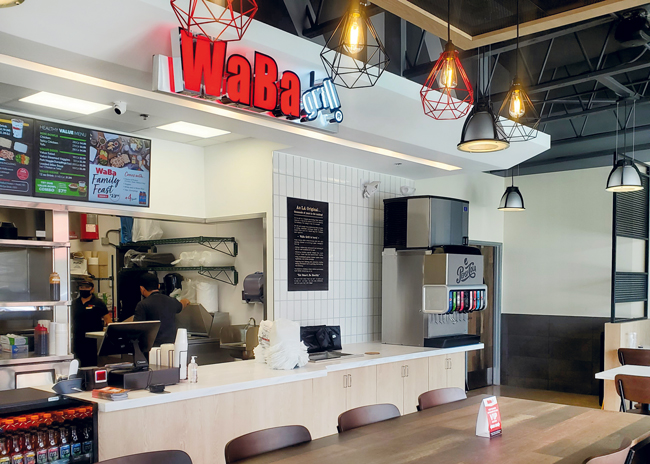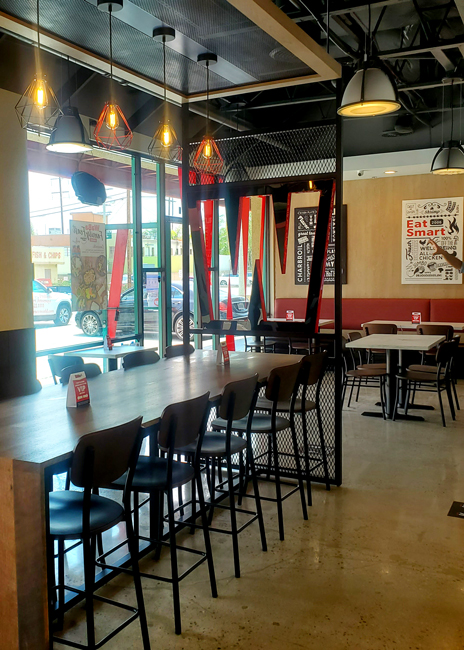A menu built on rice, protein and veggies helped this California-based chain achieve its best-ever sales during the pandemic.
 WaBa’s operations now include a staging area for online orders and an expanded POS counter to facilitate off-premises pickups.Pandemic. Lockdowns. Recession. Last year was a tough year for everyone. On a pure numbers basis, it was also the best year ever for Los Angeles-based WaBa Grill. Despite the headwinds facing the economy and the restaurant sector as a whole, WaBa set a new high for systemwide sales, besting 2019 sales by more than 3%. The chain additionally reports early 2021 sales growth in the double digits compared to the same pre-pandemic period last year. And in March 2021 a new leader took the helm when Andrew Kim was named president and CEO. He had been a longtime outside legal advisor for WaBa Grill and then joined the chain as chief legal officer in 2018.
WaBa’s operations now include a staging area for online orders and an expanded POS counter to facilitate off-premises pickups.Pandemic. Lockdowns. Recession. Last year was a tough year for everyone. On a pure numbers basis, it was also the best year ever for Los Angeles-based WaBa Grill. Despite the headwinds facing the economy and the restaurant sector as a whole, WaBa set a new high for systemwide sales, besting 2019 sales by more than 3%. The chain additionally reports early 2021 sales growth in the double digits compared to the same pre-pandemic period last year. And in March 2021 a new leader took the helm when Andrew Kim was named president and CEO. He had been a longtime outside legal advisor for WaBa Grill and then joined the chain as chief legal officer in 2018.
One of the main drivers of the chain’s growth: the menu, according to Mark Finnegan, WaBa’s chief marketing and information officer.
WaBa operates in the quick-service, healthy-eating niche. It has nearly 200 locations, primarily in Southern California. Offerings consist largely of bowls and plates with either brown or white rice along with veggies, and/or a protein, such as chicken, steak, salmon, shrimp or tofu. These straightforward combinations allow the chain to offer both Asian and Latin flavors, achieved largely through sauces. What’s more, the simplicity of the menu makes it quick and easy to execute.
If there was a year to be good with delivery, 2020 was it. With dine-in on the outs, WaBa’s online orders jumped from less than 5% of sales in 2019 to more than 25% last year.
Built for Speed
The chain’s kitchen setup and operations rely on careful planning and prep work that allow it to cut ticket times while maintaining food quality.
The core of this work is producing, portioning and, if possible, packaging entree ingredients and items that maintain quality while held. Those items that benefit most from on-demand production, such as proteins, are either cooked to order or made in batches for short holding periods during times of peak demand.
The chain has tweaked its design and operations through the years to create a highly efficient operation. WaBa introduced some of these changes along with a redesign to the front of the house last year.
WaBa’s kitchen’s layout uses a T formation. The hot line sits along the back wall, with the exact line configuration changing based on the footprint. The core pieces of equipment include two rice cookers for white and brown rice bases, plus a rangetop that staff use to heat sauces and boil dumplings before grilling. “We have a few sauce items where the best way to heat them back up is by boiling,” says Finnegan. “It is more difficult, and it takes longer, but the quality is better. That is our version of a microwave.”
In some cases, staff also use the range to steam vegetables on demand. In other locations, typically second-generation restaurant spaces with the right infrastructure, the chain uses a steamer.
The heart of the chain’s kitchen, though, is its two flattop grills. WaBa uses these to cook most of its proteins from a raw state. The culinary team uses a larger unit to cook meats, and another smaller piece to cook salmon and other delicate proteins that require a different cooking temperature.
Operations revolving around salmon have been tweaked in recent months, notes Finnegan. With a longer cook time, that protein was driving up ticket times, which proved especially troubling in units that had a drive-thru.
For a short while, WaBa experimented with a precooked salmon that staff would reheat on the grill. The quality didn’t meet the chain’s standards, though, so it switched back to raw salmon but added a bell covering for use on the flattop dedicated to cooking fish. That simple tweak brought cook times more in line with the rest of the chain’s proteins.
The chain is also exploring what other “delicate proteins” could cook here as well.
WaBa does not store its proteins in refrigeration units under the flattops. Instead, the chain keeps the proteins in its walk-in cooler and staff bring out the ingredients in batches large and small as necessary, says Finnegan. “We have a lot more control over the temperature in there, so for food-safety purposes that’s where we keep it,” he says. “When cooks are going to load a grill, they will load up a sanitized tub and then load up the whole grill. That starts the process. That’s the key to the velocity we have.”
The chargrill plays the role of partner to the flattops. In some cases, staff use the chargrill to cook proteins from a raw state. In others, staff use the chargrill to finish proteins, giving the items grill marks that add an authentic flair to every dish.
In working with the chargrill, WaBa shows off some of the chain’s creativity. “There are differences in the grill plates used in Asia versus South and Central America. We try to bring in different types of grills so that it reflects the inspiration of where the menu item comes from,” says Finnegan.
After grilling, proteins can either go to a set of steam tables along the back wall for short holding periods — more of a “pause,” says Finnegan — or directly to the assembly area. This assembly area sits perpendicular to the hot line, creating the core of the T shape in the kitchen. The centerpiece of the assembly line is a double-sided work surface sitting on top of refrigeration units that hold presliced avocados, served in halves, along with other cold ingredients.
When an order comes in, team members retrieve a protein from the steam tables or a team member passes the item directly from the hot line. They also turn to one side wall to access the rice warmers, separate from the rice cookers on the hot line. During peak hours the chain may preportion rice into bowls and onto plates to speed up service. On the other side wall, WaBa has its salad table, where staff create dishes like the house chicken or spicy Asian chicken salad.
After assembling a dish, staff send it either to the drive-thru, the counter for guests ordering on-site or to a holding area for online orders. The operations around digital orders have changed as part of WaBa’s redesign.
Previously, guests and third-party delivery partners picking up to-go orders had to queue in the same line as customers ordering on-site. This would lead to people waiting in line for food that was sitting just behind the counter. At the same time, the longer line could delay guests ordering for dine-in service and even potentially disrupt people sitting down to enjoy their meals.
In response, WaBa added shelving behind the counter for staging to-go meals and expanded its counter space to facilitate off-premises pickups, says Finnegan. Guests and drivers picking up such an order can now “semi-queue” around the counterspace to the side of the registers, allowing the chain to offer a better experience in both the dine-in and to-go arenas.
Emphasis on Health, Chain Growth
 New design elements include a polished concrete floor, open ceiling and custom light fixtures.The redesign highlights WaBa’s strength of serving healthful, fresh food. “We use fresh, never frozen chicken, and we marinate our own steak. We wanted materials in the design that reflect that natural, fresh feeling,” Finnegan says.
New design elements include a polished concrete floor, open ceiling and custom light fixtures.The redesign highlights WaBa’s strength of serving healthful, fresh food. “We use fresh, never frozen chicken, and we marinate our own steak. We wanted materials in the design that reflect that natural, fresh feeling,” Finnegan says.
The space, then, makes use of polished concrete flooring and open ceilings. While the chain went with lower-cost options in some places, it splurged in others. “Customers like a good surface to eat on and a good clean countertop when they’re getting their food. Those are quartz. That’s one of the areas where we are spending a little bit more money,” Finnegan says.
Other design touches more explicitly connect with the chain’s value proposition, such as signage and wall decor that tout WaBa’s fresh proteins and “Eat Smart, Be Healthy” tagline. These visual elements, says Finnegan, sum up why guests choose WaBa. “Those are the three aspects of what makes WaBa unique: What we do to our proteins, how we select our cooking methodologies and our commitment to making sure that it’s a place where you can eat smart and be healthier than you can at other options out there.”
More WaBa Grills are, of course, planned for the future with a notable “aggressive push outside the Los Angeles area, according to Finnegan.” Target markets include San Diego as well as Central and Northern California. Additional target markets include Arizona, Nevada and possibly even New Mexico. With a thoughtful growth plan and operations designed for speed and quality, the chain could be setting new records in the years to come.
Facts of Note
Key players
President and CEO: Andrew Kim
Chief marketing and information officer: Mark Finnegan
Chief restaurant and development officer: Afshin Compani
Chief organizational and human resources officer: Renny Freet
Interior designer: The Retail Element, Santa Fe Springs, Calif.
Chain headquarters: City of Industry, Calif.
Year founded: 2006
Signature menu items: Rice bowls and plates
Number of units: 192
Total system sales: $140 million
Unit growth projections: Beginning new market expansion in 2021



